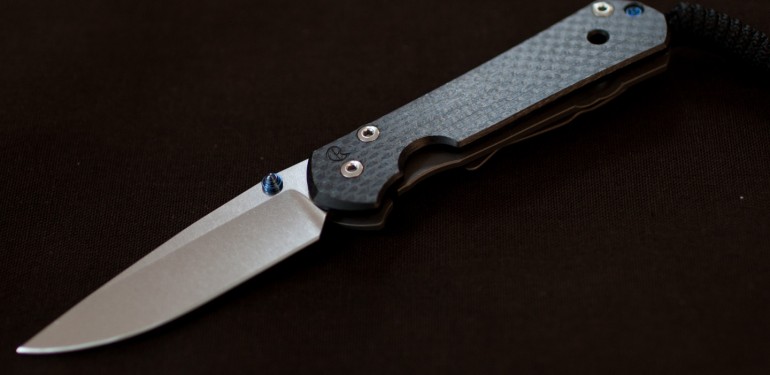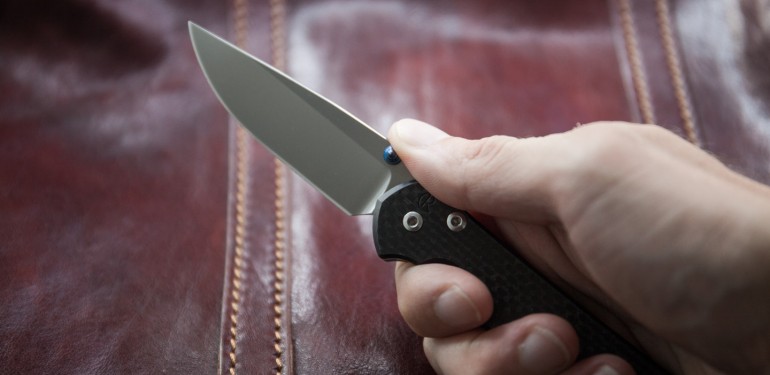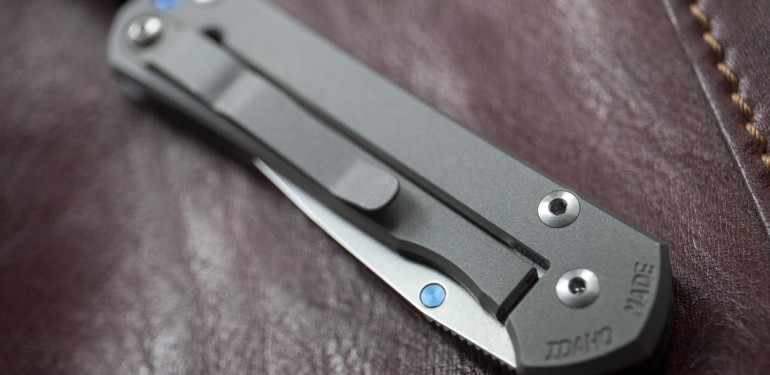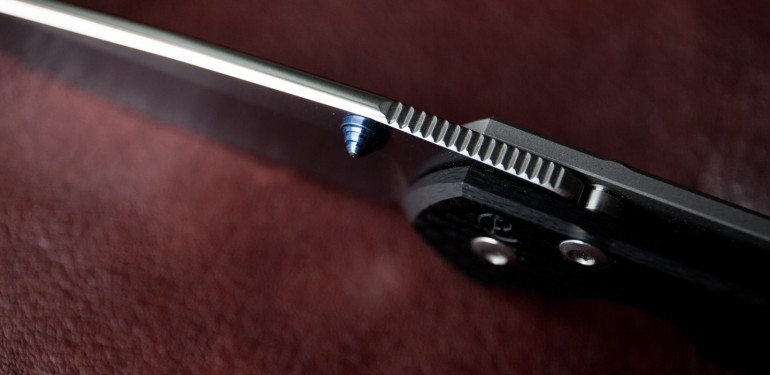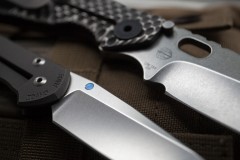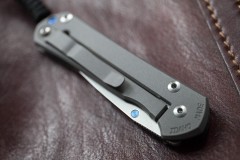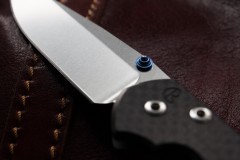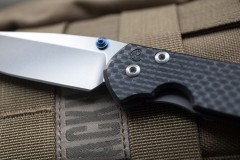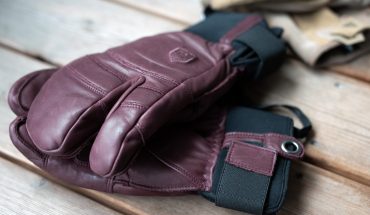The Sebenza is the benchmark of the modern locking folding knife and is also the one that started it all. It was introduced in 1990 and featured the Reeve Integral Lock, an evolution of the Walker Linerlock that uses the entire titanium handle as a locking mechanism. Over the years it has gone through a few minor alterations and this review is a closer look at the Small Sebenza 21 made exclusively for Knifeart.com which has a carbon fiber presentation side handle but is otherwise standard.
Chris Reeve started selling knives as a company, the Chris Reeve Knives sole proprietorship, in 1984 out of his garage in South Africa. Increasing exports to the United States and other international customers led him to move to Boise, Idaho in 1989. His bread and butter those days were the one-piece range of fixed blade knives. The concept for the Sebenza was developed in 1987 and introduced to the bigger public in the fall of 1990 in an article of Fighting Knives. This magazine article resulted in the first 75 retail orders. Production started in 1991 with the first 86 Sebenzas made entirely by hand. The company had previously reinvested all profits into machinery and soon invested in CNC equipment as a result of Mr. Reeves quest for increased efficiency and ultimate production quality.
A new profile for the knife was introduced in 1996, known as the Regular, while the original design was discontinued. Due to popular demand the Classic was introduced in 2000 with the same angular profile and only minor differences of the original. Both versions were replaced by the Sebenza 21 in May 2008 which only differs slightly from the Classic. These knives have all been available in both a small and large version featuring a 2.94″ and 3.635″ blade, respectively. In 2012 a new model called the Sebenza 25 was introduced to commemorate the 25 years since the inception of the design. This version is only available in the bigger size and has more significant changes, among them double finger choils, a different profile thumb ramp, a thicker blade and various technical enhancements.
Sebenza is Zulu for Work
From the start the Sebenza was envisioned as a knife that was made to be used as a working knife for a variety of field tasks. It was in the first wave of knives after Michael Walker’s utility liner locks and Bob Terzoula ACTF, who also coined the term “tactical folding knives”. The Frame lock mechanism of the Sebenza has since become the standard lock which almost all knives of the type use. A better term nowadays is “modern locking utility knives” as they are tools suitable for all kinds of tasks around the house or out in the field for both professional servicemen and civilians alike. Although not primarily designed as fighting knives, they are built to work as a self-defense weapons if needed.
Although the blade of the small Sebenza is almost 3″ (72 mm) long the combination of a slimmer profile, superb finishing and less sculpted handles really makes it feel like another type of knife than more utilitarian 3.5″ locking folders such as the Strider SNG and TAD Dauntless. I would classify it as a modern gentleman’s folder even though it’s a direct ancestor to those knives. One way to think of it is like an AMG Mercedes, for 99% of the time you have no use of the beefed up suspension, brakes and engine and you just coast along enjoying the ride. But when you do need the power, it’s there.
The positive side is that it’s completely non-threatening, no one will look sideways at you when hauling one of these up. It’s easy to argue for its usability and EDC value even for IT-professionals and lawyers; my personal guess is that the number one task aggregated among all Sebenzas is opening boxes, and it really excels at that. The downside is that it’s almost too pretty, I sometimes hesitate picking it since I don’t want the blade covered in tape residue or scratched from staples.
It has a fairly basic shape made out of two flat handle slabs with almost Gothic points at both rounded ends and a slight curvature to the top and bottom lines. The blade is a classic drop point with a slight protruding thumb ramp featuring fine jimping, 3.175 mm thick and 24 mm wide at its widest point. It has an overall length of 212 mm (100 mm closed) and a thickness of 10 mm. The standard model with two titanium frame slabs weighs in at 85 g, Knifeart.com’s version with a carbon fiber presentation side weighs 65 g making an already light knife even lighter.
All visible edges of the frame slabs are chamfered but the pivot and stand-offs are not countersunk and protrudes from the handles. The screws themselves have a satin finish. There’s an extra hole seemingly without purpose on the back end of the knife, this is a tooling hole for locating the work piece during machining. This hole is now superfluous and has also been removed in the Sebenza 25, but it’s a bit of a letdown in what’s otherwise a masterclass in machining.
The blade has a very fine stonewash made using ceramic media, at a first glance it almost looks like a satin finish. The spine is rounded off in a way that both feels and looks amazing and almost sensual. There are no grind lines visible like those on the TAD Dauntless MK 3 or the Strider SNG even though the stonewash is so much finer.
A sandblasted finish is applied to the titanium frame parts resulting in a matte surface that I believe looks a bit too rough compared to the rest of the knife. Although the surface looks like a magnet for finger prints it really isn’t. The polished and turned thumb stud, rear spacer and lanyard pivot bar are made from titanium that’s anodized blue. Rounding off this specific knife is the semi-gloss carbon fiber presentation side and a black lanyard, the standard small Sebenza has a presentation side similar to that of the lock side.
Evident in the carbon fiber is the attention to detail and incredibly tight production tolerances the company strives for. On the inside of the handle you can see a perfect basket weave pattern, but due to lapping to get the piece flat within specification the presentation side has an uneven pattern. The knife is designed and built with these tolerances to allow easy disassembly and reassembly.
Most manufacturers void warranty if the customer takes the knife apart since they often can’t get it back together properly. Chris Reeve encourages this to help cleaning since the tolerances will make it go back and function just as well as when it first leaved the factory. During assembly the lock geometry is adjusted by hand to provide the right feel. Chris Reeve Knives won the Manufacturing Quality Award at Blade Show in an unprecedented streak from 2000-2012 and the Sebenza itself won Most Innovative Folder at the Show for the 1993 Knifemakers’ Guild awards.
The Reeve Integral Lock
The locking mechanism developed by Chris Reeve for the Sebenza is now known simply as the titanium Frame lock and is the system the vast majority of hard use folders use. The original name is the Reeve Integral Lock, abbreviated R.I.L. and also called the Sebenza Integral Lock sometimes, since it was integrated into and used the frame instead of using a liner as the predecessor did, the Walker Linerlock.
It’s a system that’s just beautiful in its simplicity. On the lock side of the frame a lock bar is cut out and machined to reduce its thickness, it essentially becomes a leaf spring pressing against the rear of the blade when locked in the opened position. The other major inventions carried over from the Walker Linerlock was the detent ball, hold by the lock bar, that prevents the blade from falling out when in closed position and the blade stop pin. This pin works together with the lock bar and pivot to lock the blade using three points of contact for a completely play free and incredibly strong lockup of the blade when opened.
One of the additional benefits of these types of locking mechanisms is that they’re self-regulating. Over time the titanium lock bar face will wear against the harder steel blade, or debris will stick to the face of the lock bar, slightly changing the actual geometry. Due to the angles of the faces it will continue to work and just change when the faces actually locks against each other.
A pair of perforated phosphor bronze bushings provide a friction surface for the blade and keeps it wiggle free. The holes allow lubrication to remain where it’s supposed to be and also capture dirt and debris that would otherwise find its way onto the bushing surface instead. It uses stand-offs to allow compressed air or a rag to clean out the inside without having to take the knife apart.
It’s in the Steel
The blade stock is pretty thick but deep hollow grind makes it an exceptional cutter. The long belly gives plenty of edge to slice with and the point is very sharp for precision work. There’s quite fine jimping on top of the thumb ramp and the rear of the edge is slightly dulled so that you can really choke up on it. It really is one of the most versatile blades out there.
Another contributing factor to the cutting performance is the CPM-S35VN steel heat treated to 58-59 RC that Chris Reeve uses. The first iterations of the Sebenza used ATS-34, then changed in 1996 to BG-42. In 2001 it was changed to CPM S30V steel after he helped Crucible develop it. From 2012 all CRK knives use CPM-S35VN which he also had a hand in developing.
Both these steels are powdered martensitic stainless steels that has vanadium and chromium content. In the S35VN niobium was added and the vanadium ratio changed for an even better carbide distribution and finer grain structure. It made what was arguably the best stainless knife steel available even better by making it tougher and easier to sharpen at the same time.
To instill confidence for its users the knife is designed and built to feel rock solid, and it does. The spring bar has much higher tension than Dauntless MK 3 and really snaps into place with a reassuring “thunk” when opened. It’s not sticky like the Strider SNG and has a better tab to unlock it, but the detent ball doesn’t spring the blade into place with the same authority as the SNG. While not looking quite as beefy as some more modern design, the pivot and lock will take a real beating before breaking. Another quite obvious difference from the Strider designs is that the rather square shape of the Sebenza doesn’t fill the hand and give the same purchase for really tough tasks.
Over the time the thumbstud anodization has been rubbed off and it doesn’t have the same vivid color as when it was new. I think a natural color would’ve been better since this is the spot that’s actually touched every single time the knife is deployed and this finish is the least durable found anywhere on the knife. Everything else about the knife looks absolutely pristine and both the blade and frame is holding up well without as much as a scratch that doesn’t rub off with a cloth. There’s no blade play or wiggle and perfect blade centering. It has a buttery smooth opening, but not entirely without resistance. The pocket clip just works, it holds the knife securely but it slides with easy when grabbed or pulled with the lanyard. It’s designed for tip up carry.
Summing Up
The Sebenza was not only the knife that created the mold for the modern folding knife, it’s also the benchmark against which all other should be compared. Both the design, utility value and the manufacturing standards are as good as it gets and are constantly updated. Design follows function in this case but the manufacturing precision and feel is also a result of usability and not a quest for premium in itself. If you’re going to get one EDC knife, this is the one.
I think that the small Sebenza is the perfect EDC size, it’s small enough to look non-threatening yet large enough for almost all tasks I can think of. Of course a bigger knife makes some tasks easier and I prefer a 3.5″ blade for a field knife, but not to the point where it weighs up the benefit of the small size and low weight in this context. The surface finishes (except for the thumb stud) holds up very well against scratches and general use.
My only gripes is the weak detent, the superfluous hole through the frame and the somewhat disjointed surface finishing. The first two are fixed in the Sebenza 25 (I would like to see them carried over to the small model) and the last is actually my mistake. The blue screws, alluring hollow grind that leads to the sexy spine combined with the timeless lines and flawless fit makes me think of it as a dress knife. Mentally, I put it in the same category as a fine watch and I expect it to be finished along the lines of Frank Fischer’s and Sebastian Larsson’s work. But I really shouldn’t. This is a working tool, at the time of its introduction designed to be the most rugged folding knife on the market.
This was my first high-end folding knife after having been a fan and user of Japanese kitchen knives for several years. As with everything else, I had to readjust. It’s a $400 knife which made me a bit careful and read things into it that I shouldn’t have. Looking at it I believe it provides good value as well, the only real competitor is the Rockstead folders which are almost twice as expensive, although also better finished.
What I need to remember is that the Sebenza is a tool designed and built for hard use. You buy it to get a as knife that is as good as possible from a user’s perspective, and that is what you get.
Chris Reeve Small Sebenza 21, Knifeart.com exclusive with carbon fiber presentation side. $395 from Knifeart.com.

